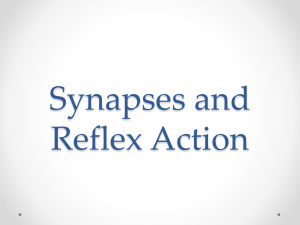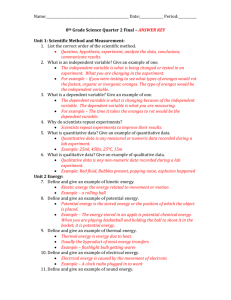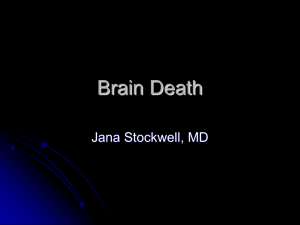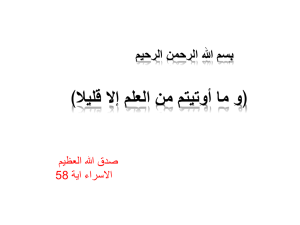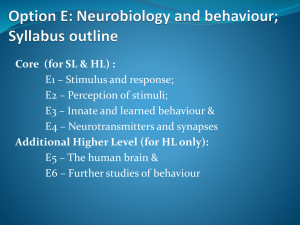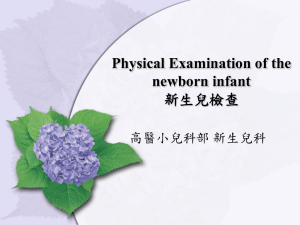Action without Attention
advertisement
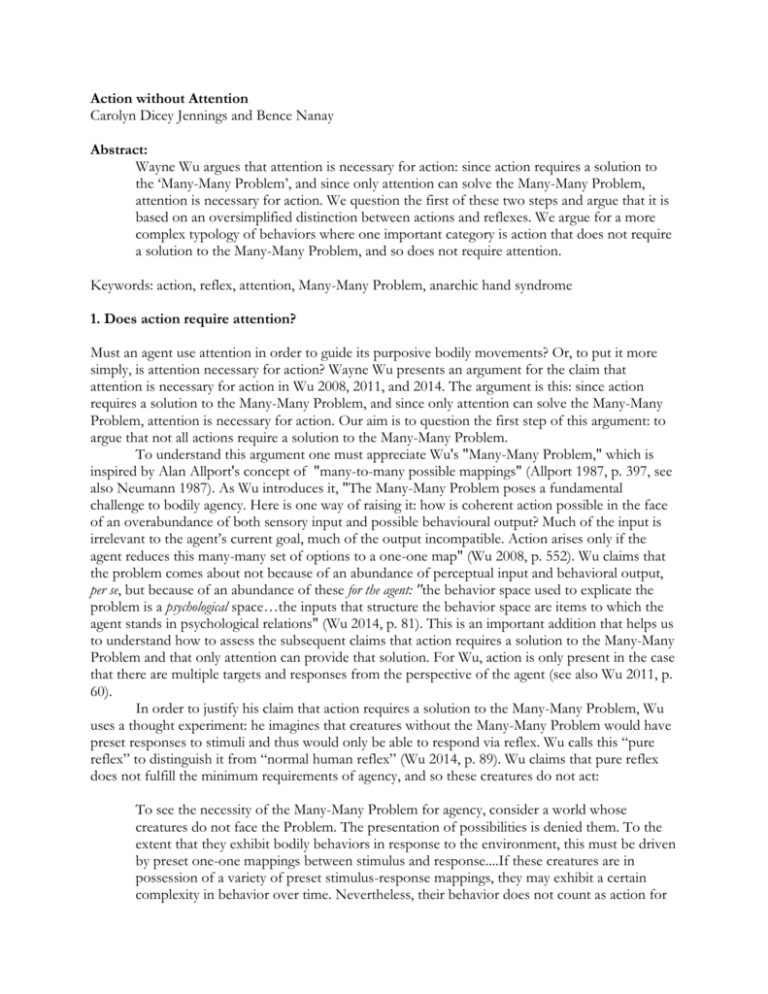
Action without Attention Carolyn Dicey Jennings and Bence Nanay Abstract: Wayne Wu argues that attention is necessary for action: since action requires a solution to the ‘Many-Many Problem’, and since only attention can solve the Many-Many Problem, attention is necessary for action. We question the first of these two steps and argue that it is based on an oversimplified distinction between actions and reflexes. We argue for a more complex typology of behaviors where one important category is action that does not require a solution to the Many-Many Problem, and so does not require attention. Keywords: action, reflex, attention, Many-Many Problem, anarchic hand syndrome 1. Does action require attention? Must an agent use attention in order to guide its purposive bodily movements? Or, to put it more simply, is attention necessary for action? Wayne Wu presents an argument for the claim that attention is necessary for action in Wu 2008, 2011, and 2014. The argument is this: since action requires a solution to the Many-Many Problem, and since only attention can solve the Many-Many Problem, attention is necessary for action. Our aim is to question the first step of this argument: to argue that not all actions require a solution to the Many-Many Problem. To understand this argument one must appreciate Wu's "Many-Many Problem," which is inspired by Alan Allport's concept of "many-to-many possible mappings" (Allport 1987, p. 397, see also Neumann 1987). As Wu introduces it, "The Many-Many Problem poses a fundamental challenge to bodily agency. Here is one way of raising it: how is coherent action possible in the face of an overabundance of both sensory input and possible behavioural output? Much of the input is irrelevant to the agent’s current goal, much of the output incompatible. Action arises only if the agent reduces this many-many set of options to a one-one map" (Wu 2008, p. 552). Wu claims that the problem comes about not because of an abundance of perceptual input and behavioral output, per se, but because of an abundance of these for the agent: "the behavior space used to explicate the problem is a psychological space…the inputs that structure the behavior space are items to which the agent stands in psychological relations" (Wu 2014, p. 81). This is an important addition that helps us to understand how to assess the subsequent claims that action requires a solution to the Many-Many Problem and that only attention can provide that solution. For Wu, action is only present in the case that there are multiple targets and responses from the perspective of the agent (see also Wu 2011, p. 60). In order to justify his claim that action requires a solution to the Many-Many Problem, Wu uses a thought experiment: he imagines that creatures without the Many-Many Problem would have preset responses to stimuli and thus would only be able to respond via reflex. Wu calls this “pure reflex” to distinguish it from “normal human reflex” (Wu 2014, p. 89). Wu claims that pure reflex does not fulfill the minimum requirements of agency, and so these creatures do not act: To see the necessity of the Many-Many Problem for agency, consider a world whose creatures do not face the Problem. The presentation of possibilities is denied them. To the extent that they exhibit bodily behaviors in response to the environment, this must be driven by preset one-one mappings between stimulus and response....If these creatures are in possession of a variety of preset stimulus-response mappings, they may exhibit a certain complexity in behavior over time. Nevertheless, their behavior does not count as action for they are driven by what are essentially a set of reflexes, and these, I take it, never exemplify agency. (Wu 2011, p. 54) For Wu, either the agent is presented with the Many-Many Problem or the agent’s behavior counts as pure reflex. There is no middle way. Wu starts by imagining a world in which the agent is not presented with possibilities and ends with a world in which the agent’s behavior is determined by preset one-to-one mappings. Here is another representative quote: An absence of a Many-Many Problem entails that any behavior generated did not occur in a behavioral space requiring selection. This implies that there were no additional behavioral paths beyond the one path taken (this includes the path of not acting). Thus, the behavioral space consists of a simple one-one mapping from target to response. All the creature could do was to act on one target in one way. This, however, is just a reflex. (Wu 2014, p. 89) Again, Wu claims that our behavior is either pure reflex or requires a solution to the Many-Many Problem, which in turn requires attention. The aim of this paper is to argue that there is a wide space in between pure reflex and the types of behavior that require a solution to the Many-Many Problem. 2. The strong and the weak interpretation According to Wu, pure reflexes have a “preset one-one mapping between stimulus and response” (Wu 2011, p. 54), whereas actions do not have this one-one mapping. There are at least two readings of this “one-one” claim, depending on how we understand its modal strength. On the weak modal reading, in the case of pure reflexes, unlike in the case of action, each type of stimulus is associated with one type of response. On the strong modal reading, the stimulus necessitates the response: we couldn’t (in some relevant sense of couldn’t) respond differently to this stimulus type. The weak reading of the claim is too weak to separate pure reflex from action. Suppose that each time you go to your favorite café you order the same thing. It may be that you do so out of pure reflex. But you may also do so because you know the menu and have figured out what you like best on it. In both cases there is a one-one mapping between stimulus and response, but in the latter case your ordering looks more like action than reflex. Thus, this weak reading of Wu’s claim won’t allow it to distinguish pure reflex from action. The strong reading, however, is too strong to capture paradigmatic cases of reflex. This seems to be admitted by Wu in separating “pure reflex” from “normal human reflex” (see citation above). In the case of the knee-jerk reflex, for instance, the tap stimulus can be present without triggering the kick response: the doctor taps your kneecap with her hammer but this does not result in a jerky kicking movement. Thus, the kick response is not necessitated by the presence of the tap stimulus in this paradigmatic case of reflex, making the strong version of the claim an unsuitable description of reflex, even “pure reflex.”1 The weak reading is able to capture these paradigmatic 1 Note that the strong reading would also cause problems internal to Wu’s account. Recall his quote above: “An absence of a Many-Many Problem entails that any behavior generated did not occur in a behavioral space requiring selection.” Thus, a strong reading of pure reflex (e.g. a reading that rules out human behavior) would require that all human behavior is subject to the Many-Many Problem. Given Wu’s depiction of the Many-Many Problem as occurring in psychological space, this would further entail that all human behavior requires selection by the agent, a result we are confident Wu would not endorse. cases because it only requires that any response is of the same type, and not that there always is a response, as in the strong reading. So neither the strong nor the weak reading of Wu’s characterization of pure reflex works. Here is an alternative way of thinking about reflex – one that is stronger than the weak reading of Wu’s account but weaker than the strong reading. Let us take the weak reading of the one-one mapping view as a starting point and add the extra condition that reflex, unlike action, does not require specific mental preparation. Actions require some kind of mental preparation – it is difficult to find any view in the philosophy of action that would disagree with this. Some even use this requirement to define what action is: "An action is defined as a movement of the body, resulting from specific mental preparation, aimed at some goal that the agent desires to achieve" (Haggard & Johnson 2003, p. 73). What is debated is what this specific mental preparation is supposed to be. It is often taken to be intention, but it is not clear what kind of intention (see, e.g., Searle 1983, Bratman 1987, Mele 1992, Pacherie 2008). To remain neutral, all we assume about actions is that they require specific mental preparation (of some kind), whereas reflexes do not require any kind of mental preparation. In the case of the café regular, for example, the ordering of a favored dish counts as action because it requires the café regular to perceive it as his or her favored dish. If the café regular ordered the dish “just because,” it might count as reflex, but the café regular orders the dish because it is his or her favorite, which is a process that includes specific mental preparation. So a behavior counts as reflex only if each time we have a stimulus of a certain type, we respond with the same response and no specific mental preparation is required for this response. This necessary condition is clearly satisfied in classic cases like the blinking reflex and the knee-jerk reflex, since in these cases no specific mental preparation is required to bring about the response. And it is not satisfied in the case of the café regular because specific mental preparation is required there. 3. Between reflexes and the Many-Many Problem Now we are in the position to ask whether the two forms of behavior sketched out by Wu—(pure)2 reflex and behavior that requires a solution to the Many-Many Problem—exhaust the full spectrum of behavioral space. The answer is clearly no. Take the following two types of behavior (which one of us called ‘semi-action’ in Nanay 2013): 1. Stimulus-Guided Behavior: a) I stand behind a strong piece of plexiglass knowing that there is plexiglass in front of me. When someone on the other side of the glass throws a beach ball at me, I reach out in an attempt to catch the ball (the example is from Nanay 2012). b) “I put my face close to the thick glass-plate in front of a puff-adder in the Zoological Gardens, with the firm determination of not starting back if the snake struck at me; but, as soon as the blow was struck, my resolution went for nothing, and I jumped a yard or two backwards with 2 We drop “pure” from this point on due to the newly adopted sense of reflex already has the “purity” condition (one-one mapping) worked into it. astonishing rapidity.” (Darwin 1899, 18) 2. Anarchic Hand Behavior: a) “‘Anarchic hand’ is the term by which we propose to identify complex goal-directed movements of a hand, which are performed against the patient’s will, and that cannot be voluntarily inhibited” (Marchetti & Della Sala 1998, 191). b) “The hand contralateral to the lesion performs simple, goal-directed actions which are not intended by the patient. Such actions might include grabbing a doorknob or scribbling with a pencil. Sometimes the anarchic hand interferes with the actions the patient is trying to perform with his ‘good’ hand. Clearly the anarchic hand is not under the control of the patient” (Frith, Blakemore, & Wolpert 2000, 358). These behaviors do not satisfy the necessary condition for reflexes outlined above. In the case of stimulus-guided action, normally seen in the sudden response to a stimulus with high valence, specific mental preparation is required to track incoming perceptual information in real time and to match that information to a particular behavior or set of behaviors. If Darwin’s jump occurred via reflex then it would not have had a direction of motion exactly in line with the puff-adder’s strike. This directionality reveals a specific mental preparation in his jump that distinguishes it from reflex. Likewise, if the subject behind the plexiglass had raised his or her hands out of reflex, then the hands would not have tracked the beach ball’s size and trajectory. This tracking, common to all instances of stimulus-guided action, requires specific mental preparation. In the case of anarchic hand behavior, specific mental preparation is required to account for the apparent goal-directedness of certain instances of the behavior. Take the instance of a subject grabbing a doorknob as an instance of anarchic hand behavior: the grabbing of the doorknob reveals the matching of perceptual information to a particular set of behaviors according to the specific goal of either turning the doorknob or, further, opening the door. But then we do have specific mental preparation in this case, which distinguishes this behavior from mere reflex. In other words, these two sets of counterexamples are genuine actions, not reflexes. But they do not invoke a Many-Many Problem because, from the perspective of the agent, there is a “preset one-one mapping between stimulus and response”. In the case of stimulus-guided behavior, a oneone mapping between stimulus and response is created without any input from the agent: if we repeated the beach ball or puff adder scenario, the same response would follow the same stimulus – at least for a couple of times until habituation sets in.3 Darwin jumps away from the strike of the puff adder despite resolving not to and despite knowing that the puff adder is behind glass. In the beach ball example, the would-be catcher raises her arms despite knowingly standing behind plexiglass that prevents the catch. Similarly, for anarchic hand behavior, the one-one mapping is not monitored by the agent nor in the control of the agent: perceiving the same doorknob would trigger the same behavior of reaching for the doorknob. This behavior is described as either occurring “against the patient’s will” or simply outside “the control of the patient”. All of these examples qualify as actions that do not require a solution to the Many-Many Problem. 3 Presumably, with effort and time, Darwin and I could resist reacting to these stimuli. But this just means that the one-one mapping between stimulus and response can be modified. But what counts from the point of view of our argument is that there is such a one-one mapping between stimulus and response before any such modification. We are grateful to an anonymous referee for raising this issue. The basic structure of our argument has been the following. Some but not all behavior has a “preset one-one mapping between stimulus and response.” And some but not all behavior results from specific mental preparation. These two types of behavior sometimes overlap, such that behavior that results from specific mental preparation may or may not have a “preset one-one mapping between stimulus and response.” If it does, it would still count as action, but would not face the Many-Many Problem. In this case, solving the Many-Many Problem is not necessary for performing genuine actions. But then the argument for the necessity of attention for performing action is blocked. 4. Conclusion We have considered two sets of counterexamples to the claim that all actions face the Many-Many Problem and therefore all actions require attention (to solve this problem). They both turn on the same move – namely, that we can have one-one mapping between stimulus and response in a way that does not exclude that the response depends (in some fairly strong manner) on our mental preparation. We can then make a threefold distinction between different kinds of behavior: a. Behavior where there is a one-one correspondence between stimulus and response and that does not result from specific mental preparation. b. Behavior where there is a one-one correspondence between stimulus and response and that results from specific mental preparation. c. Behavior where there is no one-one correspondence between stimulus and response. Reflexes, we argued, fall in category (a). Solving the Many-Many Problem is required for (c). And while Wu seems to think that (a) and (c) exhaust the possibilities, we argued that (b) is an important intermediary case: behavior in (b) would count as action that does not face the Many-Many Problem.4 University of California, Merced 5200 N. Lake Rd., Merced, CA 95343, U.S.A. cjennings3@ucmerced.edu and Funding University of Antwerp and Peterhouse, Cambridge University Peterhouse, CB2 1RD, UK bence.nanay@uantwerpen.be or bn206@cam.ac.uk This work was supported by the EU FP7 CIG grant PCIG09-GA-2011-293818 and the FWO Odysseus grant G.0020.12N. References 4 We are grateful for comments by Wayne Wu and an anonymous referee. The contributions of the two co-authors were equal – authors are listed in alphabetical order. Allport, D. A. 1987. Selection for action: Some behavioral and neurophysiological considerations of attention and action. In Heuer, H. and Sanders, A. F., editors, Perspectives on Perception and Action. Lawrence Erlbaum. Bratman, M. 1987. Intention, plans, and practical reason. Cambridge, MA: Harvard University Press. Darwin, Charles 1899. The Expression of Emotion in Man and Animals. New York: Appleton. Davidson, D. 1971. Essays on actions and events: Philosophical essays. Oxford: Oxford University Press. Frith, C.D., Blakemore, S.J., Wolpert, D.M. 2000. Abnormalities in the awareness and control of action. Philosophical Transactions of the Royal Society of London B Biological Sciences, 355: 1771-1788. Haggard, P. and Johnson, H. 2003. Experiences of voluntary action. Journal of Consciousness Studies, 10: 9-10. Marchetti, C. and Della Sala, S. 1998. Disentangling the alien and anarchic hand. Cognitive neuropsychiatry, 3: 191-207. Mele, A. R. 1992. Recent work on intentional action. American Philosophical Quarterly 29: 199-217. Nanay, B. 2012. Action-oriented perception. European Journal of Philosophy 20: 430-446. Nanay, B. 2013. Between Perception and Action. Oxford: Oxford University Press. Neumann, O. 1987. Beyond capacity: A functional view of attention. In Heuer, H. and Sanders, A. F., editors, Perspectives on Perception and Action. Lawrence Erlbaum. Pacherie, E. 2008. The phenomenology of action: A conceptual framework. Cognition 107: 179-217. Searle, J. R. 1983. Intentionality. Cambridge: Cambridge University Press. Wu, W. 2008. Visual attention, conceptual content, and doing it right. Mind, 117: 1003-1033. Wu, W. 2011. Confronting Many-Many Problems: Attention and Agentive Control. Noûs, 45: 50-76. Wu, W. 2014. Attention. London: Routledge.


